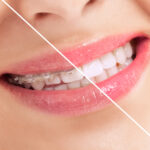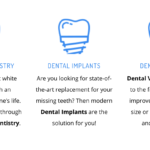Have you ever stopped to consider the artistry of orthodontics? Orthodontists are a unique breed of healthcare professionals who work hard to create beautiful, functional smiles for their patients. But what makes them different from most other healthcare providers is that they also possess an artistic eye and a knack for creating aesthetically pleasing results. In this article, we will explore the art of braces – why orthodontists must have both clinical and creative skills to be successful, and how some orthodontists are taking their art to the next level by incorporating traditional art techniques into their practice. Read on to learn more about this fascinating field of dentistry!
What is orthodontics?
Orthodontics is the branch of dentistry that deals with the correction of malpositioned teeth and jaws. It is also concerned with the enhancement of the appearance of the teeth and face. Orthodontic treatment can improve the function and appearance of the teeth and jaws, and it can also help to prevent or correct dental problems that may occur in later life.
The history of braces
The first braces were invented in 1728 by French dentist Pierre Fauchard. He used adevice called a “bandeau” to align teeth. This early braces appliance consisted of a strip of metal that was wrapped around the teeth and held in place with wire. In 1819, another French dentist, Jules Guerin, developed a more comfortable version of braces made from vulcanized rubber.
In 1843, American doctor Edward H. Angle devised an orthodontic appliance that is recognizably similar to modern braces. His innovation was to attach the brackets directly to the teeth using metal bands instead of wrapping them around the entire tooth. This invention revolutionized the field of orthodontics and paved the way for the development of many different types of braces appliances that are used today.
How braces have evolved
While braces have been used to correct teeth for centuries, the tools and techniques Orthodontists use have evolved considerably. Modern braces are far less noticeable than their predecessors and can be made from a variety of materials, including clear plastic or ceramic. Newer technologies, such as invisible aligners, have also emerged as popular alternatives to traditional braces.
Orthodontists now have a wide range of options to choose from when it comes to correcting teeth. However, despite all of the advances in orthodontic care, the basics of braces remain the same. Braces are still essentially two metal wires that are tightened or loosened in order to move teeth into the desired position.
While the technology and materials used in braces have come a long way, the basic principles of how they work have remained unchanged.
Braces as an art form
While braces may not be the first thing that comes to mind when you think of art, there is no doubt that orthodontics is an art form. From the simple metal braces of the past to the clear ceramic braces of today, each set of braces is a work of art.
Orthodontists use a variety of techniques to create beautiful smiles. They take into account the shape of your face, the size of your teeth, and the way your teeth come together when you bite. They then use this information to create a treatment plan that will give you the best results.
Braces are not just for kids anymore. More and more adults are choosing to get braces to improve their smile. And with all of the different options available, there is sure to be a type of braces that is perfect for you.
So whether you are looking for a way to improve your smile or you just appreciate the artistry of Orthodontics, be sure to check out The Art of Braces – Orthodontics as an Art Form!
The different types of braces
There are many different types of braces that can be used to straighten teeth, and each type has its own advantages and disadvantages. The most common type of braces is metal braces, which are made of stainless steel or titanium. Metal braces are the strongest type of braces and can be used to correct even the most severe cases of misaligned teeth. However, they are also the most visible type of braces, so if you’re looking for a more discreet option, you may want to consider one of the other types of braces. Ceramic braces are made of clear or tooth-colored brackets and wires, so they’re much less visible than metal braces. They’re also weaker than metal braces, so they may not be suitable for very severe cases of misaligned teeth. Invisalign® is a type of clear plastic aligner that is virtually invisible when worn. It’s a popular choice for adults who want to straighten their teeth without anyone knowing they’re doing it. However, Invisalign® aligners must be removed while eating, drinking, brushing, and flossing, so they require a high level of compliance from patients.
How to choose the right type of braces
There are a few different types of braces that an orthodontist can use to straighten your teeth. The type of braces that you choose will depend on your individual situation, budget, and preferences. Here are a few things to consider when choosing the right type of braces for you:
– Metal braces are the most common type of braces. They are also the most affordable option. Metal braces are made of high-grade stainless steel and are very strong. They are less visible than other types of braces, making them a good option for adults who want to straighten their teeth discreetly.
– Ceramic braces are made of clear or tooth-colored brackets. They are less visible than metal braces, making them a good option for adults and teens who are concerned about their appearance. Ceramic braces are more fragile than metal braces and can be more expensive.
– Invisalign is a popular alternative to traditional braces. Invisalign uses clear, removable aligners instead of brackets and wires. Invisalign is virtually invisible and can be removed for eating, drinking, and brushing your teeth. However, Invisalign can be more expensive than traditional braces.
One of most popular cosmetic dentistry treatments is teeth whitening which a good treatment you should consider before having a braces. Your orthodontist will help you choose the right type of braces for your individual needs.
Why dental marketing is important?
When it comes to marketing, dental practices have a lot to consider. They need to find ways to attract new patients while also maintaining good relationships with existing ones. That’s why dental marketing is so important.
There are a number of different ways to market a dental practice. Traditional methods like advertising in newspapers and Yellow Pages can still be effective, but it’s important to also consider newer methods like social media and online directories. No matter what methods you use, the goal should be to reach as many potential patients as possible and make them aware of your practice.
Dental marketing can be a complex task, but it’s one that’s essential for any practice that wants to succeed. By taking the time to develop a comprehensive marketing strategy, you can increase your sales with dental marketing and your practice will be able to attract new patients and keep existing ones coming back.
Conclusion
Orthodontics is a medical specialty that has been successfully used to treat malocclusion and other dental irregularities for decades. It is also an art form, as demonstrated by the various techniques and instruments used to create beautiful smiles in patients with crooked teeth or maligned jaws. We hope that you now have a better understanding of how braces can be used as an art form and why it’s important for orthodontists to pay attention to both function and aesthetics when creating treatment plans for their patients.








